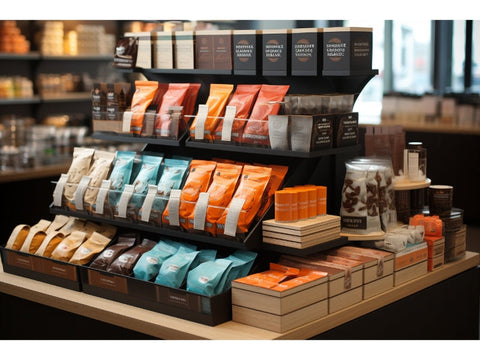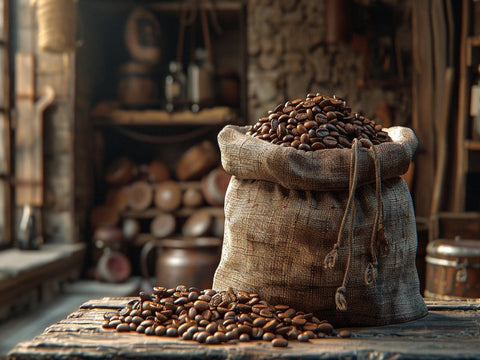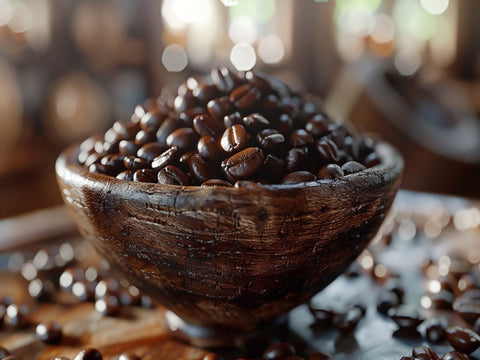Coffee is a highly prized and beloved beverage worldwide, with millions of people starting their day with a fresh cup of java. However, to experience the full flavor and aroma of coffee, proper storage is crucial. Storing coffee beans the right way can preserve their freshness and maintain their quality for a longer period, ensuring the perfect cup of coffee every time.
The best ways to store coffee beans are:
- Keep them in an airtight container to prevent exposure to air and moisture.
- Store them in a cool, dark place to maintain their freshness.
- Avoid moisture and heat as they can cause the beans to lose their flavor and become stale.
- Use a vacuum sealer to remove excess air and preserve freshness.
When stored properly, coffee beans can last for up to 6 months. However, the storage duration may vary depending on several factors such as the type of beans, whether they are whole or ground, and the type of roast.
It is important to note that roasted beans have a shorter shelf life compared to unroasted beans. Additionally, ground beans have a larger surface area exposed to air, making them go stale quicker than whole beans.
Signs of stale coffee beans include a loss of aroma, a change in color from dark to pale, and a bitter or stale taste. To ensure you always have a fresh cup of coffee, it is essential to store different types of coffee beans properly.
Arabica beans, the most popular type of coffee, should be stored in an airtight container in a cool, dark place. Robusta beans, known for their high caffeine content, should be stored in a similar manner. Flavored beans, which are more susceptible to losing their flavor, should be stored in an airtight container away from heat and moisture. By following these storage methods, you can prolong the freshness of your coffee beans and enjoy a delicious cup of coffee every time.
Read: The Differences Between Arabica And Robusta Coffee
Key Takeaways:
Why Is Proper Storage Important for Coffee Beans?
Proper storage of coffee beans is essential for maintaining their freshness, flavor, and aroma over time. Exposure to air, light, moisture, and heat can cause the beans to quickly deteriorate, resulting in a stale and unappealing brew. By understanding the importance of proper storage for coffee beans, coffee enthusiasts can guarantee that their beans remain at their best quality, unlocking a truly satisfying coffee experience.
What Are the Best Ways to Store Coffee Beans?

Read: The Easy Guide to Coffee Bean Storage
1. Keep Them in an Airtight Container
When storing coffee beans, it's crucial to keep them in an airtight container to preserve their freshness and flavor. Follow these steps:
- Grind the coffee beans to a coarseness suitable for your brewing method.
- Transfer the ground coffee to a clean, airtight container.
- Seal the container tightly to prevent air exposure.
If you're wondering about the history of coffee, it is believed that coffee was first discovered in Ethiopia in the ninth century. As the legend goes, a goat herder named Kaldi noticed his goats became energetic after eating certain berries, leading to the realization of the stimulating effects of coffee.
2. Store Them in a Cool, Dark Place
When it comes to storing coffee beans, it is important to keep them in a cool, dark place to maintain their freshness. Here are some steps to ensure optimal storage:
- Find an airtight container to shield the beans from light and air exposure.
- Select a cool spot, such as a pantry or cupboard, to protect the beans from heat and keep them in a dark place.
- Avoid storing the beans near appliances that emit heat, and keep them away from sources of moisture.
- Consider using a vacuum sealer for an extra layer of protection against air and moisture.
For the best coffee experience, remember to store your beans in a dark place and savor the rich flavors to the last drop!
3. Avoid Moisture and Heat
- To avoid moisture and heat, it is important to store coffee beans away from sources of heat such as stoves or ovens.
- Direct sunlight and moisture can also cause flavor degradation, so it is best to keep the beans away from these elements.
- To protect the beans from moisture and heat exposure, store them in an airtight container.
Fun Fact: Moisture and heat are the top enemies of coffee beans, causing them to quickly lose flavor and aroma.
4. Use a Vacuum Sealer
- Make sure to allow the coffee beans to cool completely before vacuum sealing.
- Use a vacuum sealer with a designated setting for coffee to avoid crushing the beans.
- Divide the beans into small portions for single-use and vacuum seal each portion individually.
One time, a friend used a vacuum sealer to preserve a batch of freshly roasted coffee beans. After a month, the beans still maintained their rich flavor and aroma, demonstrating the success of using a vacuum sealer to preserve the freshness of coffee.
How Long Can Coffee Beans Be Stored?

When it comes to storing coffee beans, there are several factors to consider. From the type of bean to the method of storage, each element can impact how long your beans will stay fresh. In this section, we will discuss the differences between whole beans and ground beans, as well as the effects of roasting and unroasted beans on storage time. Additionally, we will cover the various types of roasts and their impact on the shelf life of coffee beans. By the end, you will have a better understanding of how long you can store your coffee beans for optimal freshness.
1. Whole Beans vs Ground Beans
- Whole beans: Retain flavor and freshness longer due to less surface area exposed to air. It is recommended to grind them before brewing for optimal taste.
- Ground beans: Convenient for quick brewing but lose flavor faster than whole beans due to increased exposure to air and light.
2. Roasted vs Unroasted Beans
Roasted vs unroasted beans offer different flavors, shelf lives, and usage options.
Roasted beans provide complex flavors, a shorter shelf life, and are ready for brewing. On the other hand, unroasted beans have a longer shelf life, a grassy flavor, and must be roasted before use.
3. Types of Roasts
- Light Roast: This roast has a light brown color and a milder flavor, preserving the unique characteristics of the bean.
- Medium Roast: With a richer flavor and darker color, this roast balances between acidity and body.
- Dark Roast: Recognizable by its shiny surface and bold flavor, this roast often has an oily texture and pronounced bitterness.
What Are the Signs of Stale Coffee Beans?
As coffee enthusiasts, we all want to ensure that our beans are as fresh as possible for that perfect cup of joe. But how do we know if our beans have gone stale? In this section, we will explore the tell-tale signs of stale coffee beans so you can avoid drinking a lackluster brew. From the loss of aroma to changes in color and a bitter or stale taste, we will discuss the visual and sensory indicators that your coffee beans have passed their prime.
1. Loss of Aroma
For optimal coffee flavor, it is important to prioritize storing beans properly in order to preserve their aroma and quality. This can be achieved by keeping them in airtight containers, away from heat and moisture, ensuring that you can enjoy fresh coffee every time.
- To prevent 1. loss of aroma, store coffee beans in an airtight container.
- Place the container in a cool, dark place away from sunlight and heat sources.
- Avoid moisture and heat to maintain the beans’ freshness.
- Consider using a vacuum sealer for long-term storage.
2. Change in Color
Changes in color may indicate that coffee beans have deteriorated. To identify these changes:
- Compare the beans to their original color for any noticeable darkening.
- Look for an uneven color distribution, which could signal staleness or inadequate storage.
- Inspect for the presence of oily spots or a greasy sheen on the beans, as this could indicate overexposure to air and light.
To maintain freshness and flavor, it is important to store coffee beans in an airtight container, away from light, heat, and moisture. This will ensure a delightful coffee experience.
3. Bitter or Stale Taste
- To prevent exposure to air and moisture, ensure proper storage in an airtight container.
- For optimal freshness and to prevent flavor degradation, store coffee beans in a cool, dark place.
- Avoid a bitter or stale taste by keeping coffee beans away from heat and moisture.
- Prolong the shelf life of coffee beans by using a vacuum sealer.
I learned from experience that storing coffee beans in a transparent jar on the kitchen counter can result in a bitter taste. To avoid this, I now store my coffee beans in an airtight container, ensuring a fresh and flavorful coffee experience every time.
How to Store Different Types of Coffee Beans?

Proper storage is essential for maintaining the freshness and flavor of your coffee beans. However, different types of coffee beans may have different storage needs. In this section, we will discuss the best ways to store three types of coffee beans: Arabica, Robusta, and flavored beans. By understanding the specific storage requirements of each type, you can ensure that your coffee beans stay fresh and flavorful for longer. Let's dive into the world of coffee storage and discover the best methods for keeping your beans at their peak.
1. Arabica Beans
When it comes to storing Arabica beans, follow these steps:
- Use an airtight container to preserve the delicate flavors of the Arabica beans.
- Store in a cool, dark place to prevent flavor degradation.
- Avoid moisture and heat, which can compromise the quality of the Arabica beans.
For the best results, consider these suggestions to keep your Arabica beans fresh and full of flavor.
2. Robusta Beans
- Robusta beans, also known as Coffea canephora, require proper storage to maintain their flavor and quality.
- To protect against exposure to air, which can cause flavor deterioration, store robusta beans in an airtight container.
- For optimal results, keep the container in a cool, dark place to prevent heat and light from affecting the beans.
- Due to their higher caffeine content, robusta beans are more susceptible to mold and mildew, so it is important to avoid moisture.
- Regularly checking the beans for any signs of staleness will ensure that you can enjoy the best possible flavor in your coffee.
3. Flavored Beans
- For optimal taste and aroma, store flavored beans in an airtight container.
- To prevent flavor absorption, keep them away from strong-smelling foods.
- For freshness and aroma, store in a cool, dark place.
Did you know? Flavored beans are best consumed within 2 weeks for optimal taste and aroma.
Frequently Asked Questions
How should I store my coffee beans for maximum freshness and flavor?
According to the National Coffee Association, the best way to store coffee beans is in an opaque, airtight container at room temperature. Avoid clear canisters and direct sunlight, and consider investing in smaller quantities of coffee beans for fresher brews.
Is it better to store whole beans or pre-ground coffee?
It is recommended to store whole beans and grind them right before brewing for the freshest flavor. Pre-ground coffee is more susceptible to oxygen exposure and can lose freshness quickly.
What is the prevailing wisdom on freezing coffee beans?
The debate on whether to freeze coffee beans for long-term storage is ongoing. Some coffee experts recommend it, while others advise against it. If freezing beans, be sure to use a truly airtight container to prevent freezer burn and thaw them before brewing.
Read: Should You Store Your Coffee Beans In The Freezer?
How long can I store coffee beans before they lose freshness?
The shelf life of coffee beans can vary, but when stored correctly in an airtight container at room temperature, whole beans can stay fresh for up to nine months. Using the original packaging with a one-way valve can also be effective, but it is recommended to use the beans within one to two weeks.
What are some foolproof hacks for storing coffee beans?
One hack is to use an air tight clamp glass jar for storage, as recommended by food and wine associate editor, Liz Clayton. Another is to use a coffee subscription service, such as Trade or JavaPresse, which can provide freshly roasted beans in smaller portions for maximum freshness.
What is the best way to store coffee beans for the pour over method?
For the pour over method, it is recommended to use an airtight container to preserve the fresh roasted flavor. Avoid storing beans near heat sources or in direct sunlight, and consider dividing the supply into smaller portions and using the beans within one to two weeks for the best cup of coffee.


